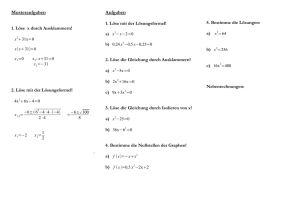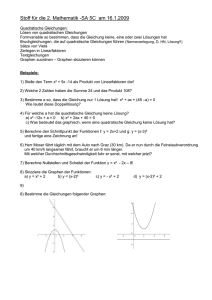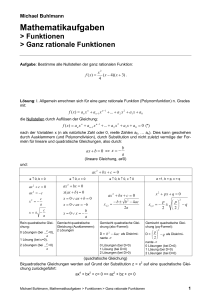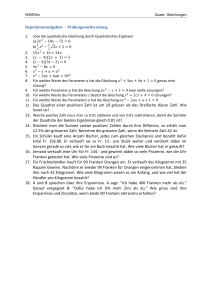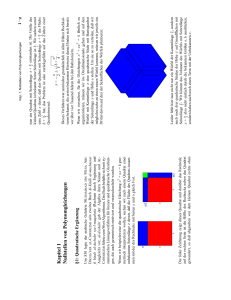Quadratische Gleichungen - LÖSUNG Jgst 10 1. Löse durch
Werbung
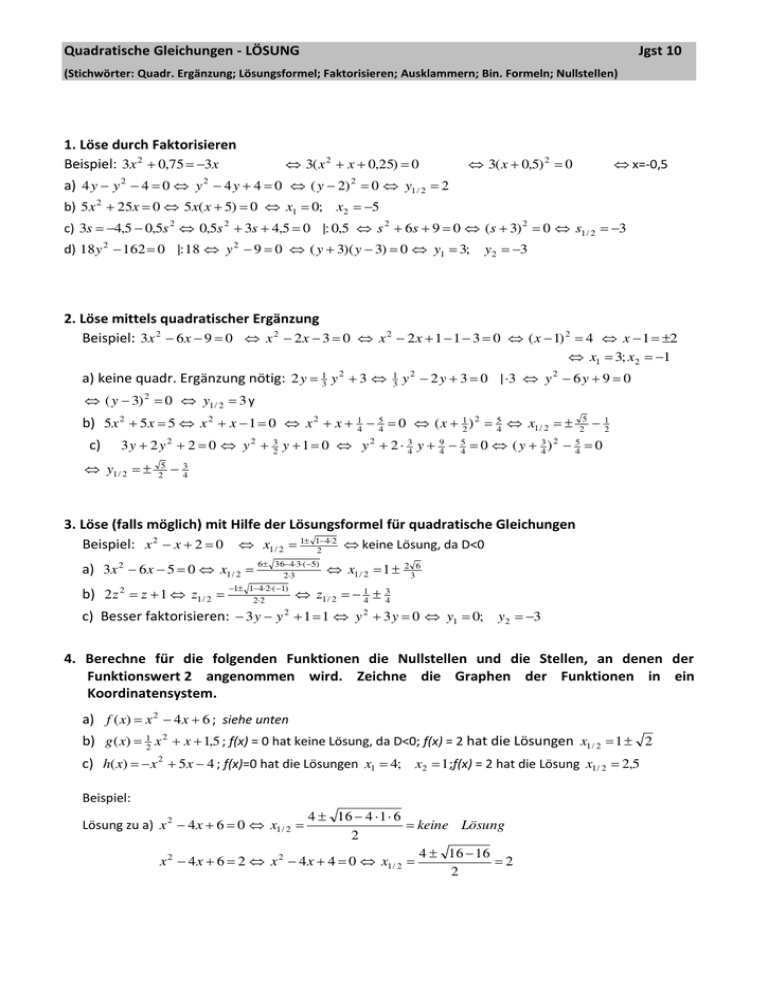
Quadratische Gleichungen - LÖSUNG Jgst 10 (Stichwörter: Quadr. Ergänzung; Lösungsformel; Faktorisieren; Ausklammern; Bin. Formeln; Nullstellen) 1. Löse durch Faktorisieren Beispiel: 3x 2 0,75 3x 3( x 2 x 0,25) 0 a) 4 y y 2 4 0 y 2 4 y 4 0 ( y 2) 2 0 y1 / 2 2 3( x 0,5) 2 0 x=-0,5 b) 5x 2 25x 0 5x( x 5) 0 x1 0; x2 5 c) 3s 4,5 0,5s 2 0,5s 2 3s 4,5 0 |: 0,5 s 2 6s 9 0 ( s 3) 2 0 s1 / 2 3 d) 18y 2 162 0 |: 18 y 2 9 0 ( y 3)( y 3) 0 y1 3; y 2 3 2. Löse mittels quadratischer Ergänzung Beispiel: 3x 2 6 x 9 0 x 2 2 x 3 0 x 2 2 x 1 1 3 0 ( x 1) 2 4 x 1 2 x1 3; x2 1 a) keine quadr. Ergänzung nötig: 2 y 13 y 3 2 1 3 y 2 y 3 0 | 3 y 6 y 9 0 2 2 ( y 3) 0 y1 / 2 3 y 2 b) 5x 2 5x 5 x 2 x 1 0 x 2 x 14 54 0 ( x 12 ) 2 54 x1 / 2 c) 5 2 12 3 y 2 y 2 2 0 y 2 32 y 1 0 y 2 2 34 y 94 54 0 ( y 34 ) 2 54 0 y1 / 2 5 2 3 4 3. Löse (falls möglich) mit Hilfe der Lösungsformel für quadratische Gleichungen Beispiel: x 2 x 2 0 x1 / 2 1 1242 keine Lösung, da D<0 a) 3x 2 6 x 5 0 x1 / 2 b) 2 z 2 z 1 z1 / 2 6 36 43( 5) 23 1 1 42( 1) 22 2 x1 / 2 1 z1 / 2 14 2 6 3 3 4 c) Besser faktorisieren: 3 y y 1 1 y 2 3 y 0 y1 0; y 2 3 4. Berechne für die folgenden Funktionen die Nullstellen und die Stellen, an denen der Funktionswert 2 angenommen wird. Zeichne die Graphen der Funktionen in ein Koordinatensystem. a) f ( x) x 2 4 x 6 ; siehe unten b) g ( x) 12 x 2 x 1,5 ; f(x) = 0 hat keine Lösung, da D<0; f(x) = 2 hat die Lösungen x1 / 2 1 2 c) h( x) x 2 5x 4 ; f(x)=0 hat die Lösungen x1 4; x2 1 ;f(x) = 2 hat die Lösung x1 / 2 2,5 Beispiel: 4 16 4 1 6 keine Lösung 2 4 16 16 x 2 4 x 6 2 x 2 4 x 4 0 x1 / 2 2 2 Lösung zu a) x 2 4 x 6 0 x1 / 2 Graphen der Funktionen: a) b) c) 5. Berechne möglichst geschickt die Lösungen der folgenden Gleichungen. Überprüfe deine Ergebnisse graphisch, z. B. mit Hilfe eines Funktionsplotters. Beispiel: 2 x 2 16 12x Bestimmung der Nullstellen der Funktion f ( x) 2 x 2 12x 16 (Graph siehe Diagramm) 2( x 2 6 x 8) 0 x1 2 x2 4 a) 2 (3 x) 2 3 x 2 x1 / 2 3 2 b) x 2 2 0,25 9 x x1 / 2 4,5 3 2 c) 2 x x 16 0 x 5 13 d) ( x 3)(x 2) 0 x1 3; x2 2 e) x 2 x x x 2 2 x 2 2 x 0 x1 0; x2 1 6. Gib jeweils eine quadratische Gleichung mit der angegebenen Eigenschaft an: a) Die Gleichung hat nur die Lösung –2. z.B. (x+2)2 b) Die Gleichung hat keine Lösungen. z.B. x2+x+1=0 c) Die Gleichung hat die Lösungen –2 und 2. z.B. (x+2)(x-2)=0 d) Die Gleichung hat die Lösungen –1 und –3. z.B. (x+1)(x+3)=0 Beispiel: Lösung zu a) ( x 2) 2 0 x 2 4 x 4 0

